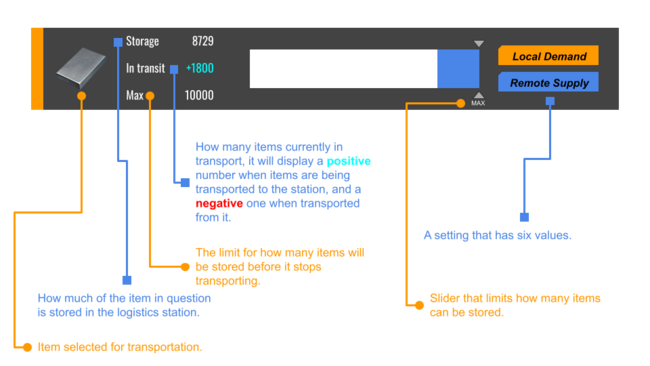imported>76561198042806868 m (fix a link) |
imported>76561198426930288 (→Minimum Load: add: if ILS is full it will always send) |
||
| Line 62: | Line 62: | ||
== Minimum Load == | == Minimum Load == | ||
'''No matter what the min load is, stations will always send ships if item storage is full.''' This is especially usefull for requesting buildings - by limiting max amount to 100 you may force ILS to send no more then 100 items at once. (note: requester does not require power, so you may request on empty planets by just setting item, max amount, and request mode) | |||
Interplanetary logistics station have several fine-grained settings. Among these, the "Min. Load of Vessels" is especially important but also counterintuitive. By default (at a min load setting of 100%) logistics vessel won't begin a delivery until there are enough items at the supplying station to completely fill a vessel (between 200-1000 items, depending on how many levels of [[Logistics Carrier Capacity (Upgrade)|Logistics Carrier Capacity]] you've researched). This is good for making efficient use of vessels for resources that you transport in bulk, but it's problematic for items that you want to store and deliver in smaller numbers, like buildings. The max storage space for an item in a logistics station can be set as low as 100, but by default such a low value means there's ''never'' enough items to fill a vessel. This is a common stumbling block for new players, and it can be difficult to figure out why nothing is getting delivered. As a rule of thumb, whenever you reduce the max number of items in a station, also reduce the min load. | Interplanetary logistics station have several fine-grained settings. Among these, the "Min. Load of Vessels" is especially important but also counterintuitive. By default (at a min load setting of 100%) logistics vessel won't begin a delivery until there are enough items at the supplying station to completely fill a vessel (between 200-1000 items, depending on how many levels of [[Logistics Carrier Capacity (Upgrade)|Logistics Carrier Capacity]] you've researched). This is good for making efficient use of vessels for resources that you transport in bulk, but it's problematic for items that you want to store and deliver in smaller numbers, like buildings. The max storage space for an item in a logistics station can be set as low as 100, but by default such a low value means there's ''never'' enough items to fill a vessel. This is a common stumbling block for new players, and it can be difficult to figure out why nothing is getting delivered. As a rule of thumb, whenever you reduce the max number of items in a station, also reduce the min load. | ||
Revision as of 09:08, 28 June 2021
How they work
There are two types of logistics stations, the first one the player unlocks is the planetary logistics station, it will only transport materials from and to other stations within the same planet using logistics drones.
The second type is the interstellar logistics station, it uses logistics vessels to transport materials from and to other planets and systems. Below you'll see illustrations on the basics of how these stations work.
The interstellar logistics station also has the same functions as a planetary logistics station, which are the "local" settings, you can see an explanation of all types of settings below.
The first image is an example of how a planetary logistics line would look like. This example shows logistics drones transporting iron ingots from one place to another. Not much changes in the second image with interstellar logistics stations, and they still have the same functionality. But compared to planetary stations, interstellar ones can also transport items from the entire solar system, and even beyond, but logistics vessels are required for them to function.
Here's how a system-wide transportation line would look like, the first planet transporting all iron ingots to a central station, which then transports it to the second planet, before being transported to their last destination. You can also have multiple stations transport the same item to the same station, instead of one centralized one.
Details
Description
There are two types of logistics stations. One is intraplanetary, which means transporting within that same planet. The other is interplanetary, which means transporting between planets. There is some confusion among people due to the use of the Latin prefixes "intra" (within) and "inter" (between), so it's important to keep this in mind while playing this game.
Intraplanetary transportation (within that same planet) is upgraded with Planetary Logistics System (Tech). Logistics Drones carry goods between Logistics Stations. To set up transportation, you need at least two stations on the same planet, and at least one drone.
At the station you wish to transport goods from, set up a conveyor belt running into the station, and then click one of the three buttons in the logistics station. Select the item you wish to transport, and set it to Supply. This tells your logistics drones that you wish to transport goods from this station to somewhere else.
At the station you wish to transport goods to, select one of the three buttons in the logistics station. Select the item you wish to receive, and set it to Demand. This tells your logistics drones that you wish to transport goods to this station from somewhere else. You will also need to run a conveyor belt out of the station, and also set the item filter to tell the station which item you want to come out of that exit. You can do this by clicking the icon near the exit and selecting the item.
Add drones to either station by shift+clicking them in. Adding a drone to a station means that the drone will fly between that station and any other, however it will always return home directly and not visit any other station along the way.
Each station will allow up to three different items which can be either supply or demand. Your drones will do all of the work as quickly as they can.
Interplanetary transportation (between planets) is upgraded with Interstellar Logistics System (Tech). Logistics Vessels carry goods between Interstellar Logistics Stations. Once again, you will need two stations, but on different planets.
The Interstellar Logistics Stations also allow transport within that same planet, so the user interface is a little more complex. Both logistics drones and logistics vessels can be assigned to these stations, and each item has two settings: Local and Remote.
Local (within that same planet), determines whether your logistics drones will carry goods in or out of that station to other places on that planet. Remote (between planets), determines whether your logistics vessels will carry goods in or out of that station to other planets.
If you set an item to Local Supply, then your local drones will carry the items to other stations on that planet. If you set it to Local Demand, then your local drones will carry items into that station from other stations on that planet. If you set an item to Remote Supply, then your interplanetary drones will carry the items from that planet to other planets, and if you set it to Remote Demand, then your interplanetary drones will transport from other planets to that one.
For example: the planet Cervus 2 has titanium, and Cervus 3 has none. There are various Logistics Stations around Cervus 2 near titanium veins, and all are set to Supply. Cervus 2 also has an Interstellar Logistics Station with titanium set to Local Demand and Remote Supply. The Logistics Drones carry the titanium from the Logistics Stations to the Interstellar Logistics Station, because it is set to Local Demand.
Cervus 3 has an Interstellar Logistics Station with titanium set to Local Supply and Remote Demand. The Logistics Vessels will carry the titanium from Cervus 2 to Cervus 3, because the Cervus 2 station is set to Remote Supply, and the Cervus 3 station is set to Remote Demand. There are also Logistics Stations on Cervus 3 set to Demand, so the Logistics Drones on Cervus 3 will carry the titanium to them.
You can also have an item being Local Supply and Remote Supply. This means that your local and remote drones will both carry the item away from the station. This only works if you have a conveyor belt carrying the item into the station. Likewise if an item is Local Demand and Remote Demand, then both your local and remote drones will try to carry items into the station, and you can run a conveyor belt out of the station.
You can set Storage on any of the above. This means that drones will leave it alone - they won't carry that item in or out of the station.
<Add screenshots and illustations>
<Perhaps mention the horribly translated message the assistant gives you>
Minimum Load
No matter what the min load is, stations will always send ships if item storage is full. This is especially usefull for requesting buildings - by limiting max amount to 100 you may force ILS to send no more then 100 items at once. (note: requester does not require power, so you may request on empty planets by just setting item, max amount, and request mode)
Interplanetary logistics station have several fine-grained settings. Among these, the "Min. Load of Vessels" is especially important but also counterintuitive. By default (at a min load setting of 100%) logistics vessel won't begin a delivery until there are enough items at the supplying station to completely fill a vessel (between 200-1000 items, depending on how many levels of Logistics Carrier Capacity you've researched). This is good for making efficient use of vessels for resources that you transport in bulk, but it's problematic for items that you want to store and deliver in smaller numbers, like buildings. The max storage space for an item in a logistics station can be set as low as 100, but by default such a low value means there's never enough items to fill a vessel. This is a common stumbling block for new players, and it can be difficult to figure out why nothing is getting delivered. As a rule of thumb, whenever you reduce the max number of items in a station, also reduce the min load.
Note that because the min load is expressed as a percentage, researching new levels of Logistics Carrier Capacity can actually break existing routes. For that reason, it's a good idea to assume the endgame maximum vessel capacity of 1000, rather than whatever capacity your vessels have right now.
Note also that the min load setting only applies to the vessels that belong to that station, regardless of whether the station is demanding or supplying. Frequently both the sender and receiver stations have available vessels, so reducing the min load on either side works. However, in situations where only one side has vessels, or on interstellar routes where only one side has Space Warpers, you need to make sure to lower the min load on that specific side.


